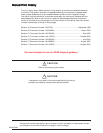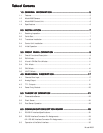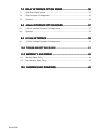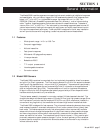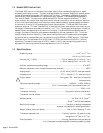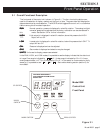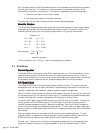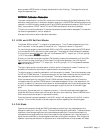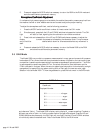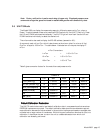
page 10 Model 2002
All six modes of the Model 2002 have features which can be accessed and modified after bypassing
the front panel interlock. The interlock is in place to prevent the accidental corruption of the
instrument’s configuration and calibration. The interlock is bypassed using the following steps:
1. Place the instrument in one of the six modes.
2. Simultaneously press the up and down switches.
The mode light will now flash indicating that the interlock has been bypassed.
Scientific NotaScientific Nota
Scientific NotaScientific Nota
Scientific Nota
tiontion
tiontion
tion
The Model 2002 measures pressure that spans more than seven decades. In order to easily display
these readings, Hastings Instruments has employed scientific notation. In scientific notation, the
mantissa (the fixed point part) is multiplied by some power of 10 (given by the exponent).
Powers of 10
10
3
= 1000 10
-1
= 0.1
10
2
= 100 10
-2
= 0.01
10
1
= 10 10
-3
= 0.001
10
0
= 1 10
-4
= 0.0001
As an example: 7.60 x 10
+2
To r r
mantissa exponent
"7.60 multiplied by 100" = 760 Torr which is one atmosphere of pressure.
3.2 RUN Mode
NorNor
NorNor
Nor
mal Operamal Opera
mal Operamal Opera
mal Opera
tiontion
tiontion
tion
The Model 2002 will automatically enter RUN mode upon start-up. This is the mode for normal
operation and the mode in which the instrument will typically spend most of its time. In the run
mode, the Model 2002 unit will continuously monitor the pressure and update the alarm conditions
at the speed of the A/D converter and will update the display about four times per second.
A/D Speed A/D Speed
A/D Speed A/D Speed
A/D Speed
AdjustAdjust
AdjustAdjust
Adjust
The Model 2002 utilizes a 24 bit sigma-delta analog to digital converter. This type of converter
averages the input over time to reject interference. Longer averaging times result in more accurate
readings. Increasing the A/D speed will respond to sudden pressure changes faster.
While in the RUN mode, the user can adjust the A/D speed of operation. At start-up, the instrument
will be operating with an A/D frequency of about 60 Hz. The speed can be adjusted one step faster
or slower. Each step will increase or decrease the A/D frequency by a factor of two.
To adjust the A/D speed, press the MODE switch until the RUN light is illuminated. Then simulta-
neously press the UP and DOWN switches. The RUN light will now flash indicating that the
interlock has been bypassed and the A/D speed can be adjusted. Push the UP switch to speed up
the A/D converter one step and decrease the response time . This will result in a faster triggering of
alarms or relays if a sudden catastrophic failure occurs. Pressing the switch after the limit is reached
has no effect.
Pushing the down switch will slow down the A/D converter and increase its accuracy. This will
improve the ability to resolve low pressure readings. If a certain speed is desired, press the UP or
DOWN switch three times and then press the other switch to select the other speed.
On older units. There will be no indication of the operating speed other than the least significant
digits of the display will tend to run at higher speeds. On units with software version 1.60 and
{



